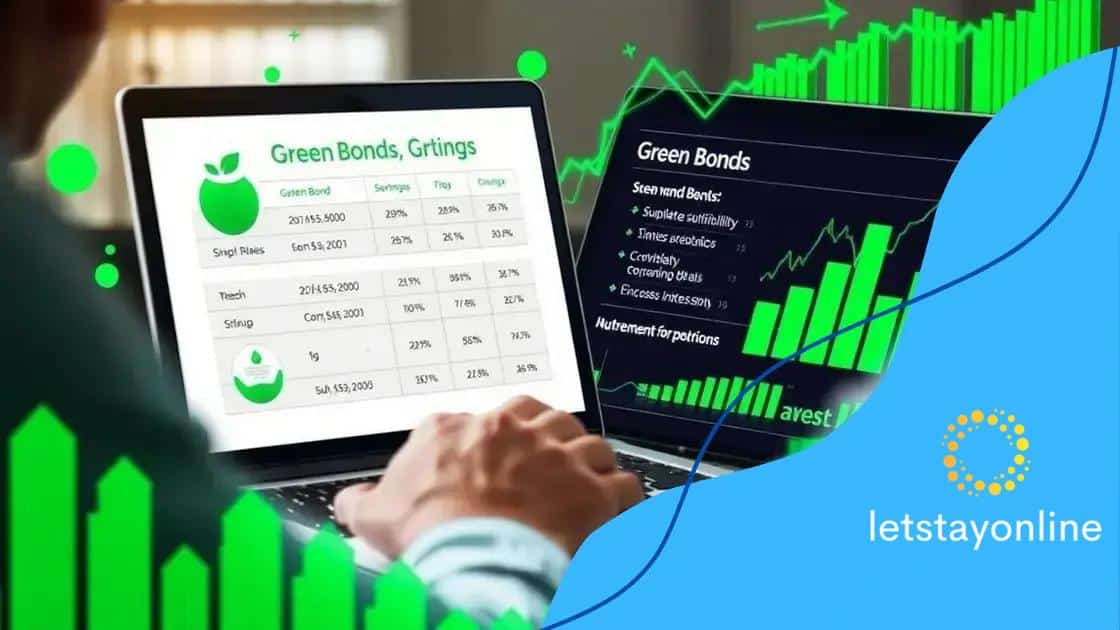Investing in green bonds: unlock sustainable opportunities

Investing in green bonds involves funding environmentally beneficial projects while aiming for stable returns, but it requires careful consideration of risks like creditworthiness and market volatility.
Investing in green bonds: have you ever wondered how your investments can contribute to a more sustainable future? These financial instruments offer an exciting opportunity to support environmental initiatives while potentially earning returns.
What are green bonds?
What are green bonds? These financial instruments are designed to fund projects that have positive environmental impacts. They are becoming increasingly popular among investors who want to contribute to sustainability.
Green bonds work similarly to traditional bonds. When you buy a green bond, you are essentially lending money to an organization, such as a government or corporation. In return, they promise to pay you back with interest over a set period. However, the key difference is that the proceeds from green bonds are specifically earmarked for environmentally friendly projects.
Key features of green bonds
Green bonds have several essential features that make them attractive to investors. Understanding these can help you decide if they are right for your portfolio.
- Use of proceeds: Funds must be used for projects that promote renewable energy, clean transportation, or water sustainability.
- Green certifications: Many green bonds have certifications to verify their environmental impact.
- Transparency: Issuers are required to report on the use of proceeds and the environmental benefits achieved.
- Market growth: The green bond market has grown significantly, reflecting a broader trend toward sustainable investing.
As more investors seek to align their portfolios with their values, the demand for green bonds is expected to grow. They not only offer the potential for returns but also allow investors to support causes they care about. This shift in investing habits is significant as it indicates a changing mindset towards sustainability and environmental responsibility.
Benefits of investing in green bonds

Investing in green bonds offers unique advantages that attract many investors. One of the main benefits is the ability to contribute positively to the environment while also seeking financial returns.
When you invest in green bonds, you support projects aimed at promoting sustainability. This aligns your investment strategy with your values, allowing you to feel good about where your money goes. In addition to feeling good, green bonds can help diversify your investment portfolio.
Financial advantages of green bonds
There are several financial benefits associated with green bonds that make them appealing:
- Stable returns: Many green bonds offer interest rates comparable to traditional bonds, providing stable income.
- Government incentives: Some governments offer tax benefits or incentives for investing in bonds that support green initiatives.
- Growing market: As the demand for sustainable investments increases, the market for green bonds continues to grow, potentially driving up their value.
- Reinvestment opportunities: Interest earned on green bonds can be reinvested into other sustainable projects, multiplying your impact.
Another significant benefit of green bonds is the increasing recognition and credibility they are gaining in investment communities. They are becoming a standard choice for socially responsible investors.
In a nutshell, investing in green bonds allows you to earn returns while supporting valuable environmental initiatives. As you consider options for your portfolio, don’t overlook the positive impact these bonds can have, both financially and ecologically.
Risks associated with green bonds
While investing in green bonds can be beneficial, it also comes with certain risks that potential investors should consider carefully. Understanding these risks is essential for making informed investment decisions.
One primary risk is that not all green bonds are created equal. Some may not adhere to strict environmental guidelines, which can lead to greenwashing. This is when a bond is marketed as environmentally friendly but may not actually fund genuine sustainable projects.
Common risks of green bonds
Investors should keep several risks in mind:
- Credit risk: Like any bond, green bonds have a risk of default. If the issuer cannot repay the bond, investors may lose their principal.
- Market risk: Changes in interest rates can affect bond prices. If rates rise, the value of existing green bonds may decrease.
- Liquidity risk: Some green bonds may not be as liquid as traditional bonds, making it harder to sell them in the market.
- Regulatory risk: The regulatory environment around green bonds is evolving, and changes in policies could impact their market value.
Additionally, since the market for green bonds is still maturing, there may be limited historical data to assess their performance accurately. This uncertainty can make it challenging to predict future returns.
Being aware of these risks helps investors weigh the potential rewards against possible downsides. By doing thorough research and assessing each green bond’s credentials, you can make smarter investment choices that align with your financial goals and values.
How to choose the right green bond

Choosing the right green bond requires careful consideration of several factors. Since these bonds fund projects aimed at promoting sustainability, it’s important to ensure that your investment aligns with your values and financial goals.
Start by understanding the issuer of the bond. Research organizations and governments that offer green bonds. Look for those with a strong track record in environmental initiatives, as this can indicate a genuine commitment to sustainability. Consider the bond’s credit rating, which reflects the issuer’s ability to repay the bond. A higher rating usually means lower risk.
Key factors to consider
When evaluating green bonds, keep these important aspects in mind:
- Use of proceeds: Verify that the funds will finance credible environmental projects, such as renewable energy or energy efficiency.
- Transparency: Look for bonds that provide detailed reports on how the funds are used and the impact of the projects.
- Return on investment: Consider the interest rate and maturity date. Make sure they align with your financial goals.
- Market demand: Research the demand for the bond, as a high demand can be a good indicator of the bond’s reliability and future performance.
It’s also wise to assess the market trends in green bonds. The demand for sustainable investments is growing rapidly, which can influence the performance of these bonds in the future. Engage with financial advisors who specialize in green investments to gain more insights.
All these factors together will help you make an informed decision when selecting the right green bond for your investment portfolio. By doing your homework, you can ensure that your investment contributes to a sustainable future while also aiming for a good return.
The future of green bonds in sustainable investing
The future of green bonds in sustainable investing looks promising as environmental concerns continue to gain traction globally. These bonds are becoming a key component of how investors approach sustainability and financial responsibility.
As more individuals and companies recognize the importance of addressing climate change, the demand for green bonds is expected to grow. This increase in demand could drive innovation and lead to the development of new types of green financial instruments.
Trends shaping the future of green bonds
Several trends are pushing the market for green bonds forward:
- Increased regulatory support: Governments worldwide are establishing policies that encourage sustainable funding. This can make green bonds more attractive to investors.
- Growing awareness: As public consciousness about climate issues rises, more investors are seeking opportunities to support environmental initiatives through their investments.
- Advancements in technology: Technology is enabling better tracking and reporting of the environmental impact of projects funded by green bonds, providing more transparency and trust.
- Collaboration among stakeholders: Governments, non-profits, and corporations are working together to create frameworks for green bonds, which can strengthen market credibility.
The integration of sustainability into investment portfolios is not just a trend, but a fundamental shift in how financial markets operate. Investors increasingly view green bonds as a way to align their values with their finances while still obtaining reasonable returns.
As the market evolves, it may attract a wider range of investors, including retail investors who want to make a positive impact. This expanded participation could lead to more capital available for sustainable projects, further enhancing the impact of green bonds.
FAQ – Frequently Asked Questions about Investing in Green Bonds
What are green bonds?
Green bonds are financial instruments used to fund projects that have positive environmental impacts, such as renewable energy or energy efficiency.
What are the benefits of investing in green bonds?
Investing in green bonds supports sustainability efforts while providing potential stable returns, similar to traditional bonds.
What risks should I consider before investing in green bonds?
Investors should be aware of credit risk, market risk, liquidity risk, and the possibility of greenwashing.
How can I choose the right green bond?
Select bonds by researching the issuer, verifying the use of proceeds, and considering the bond’s credit rating and transparency.






